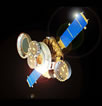Genesis opened
its collector arrays and began accepting particles of
solar wind on Dec. 3, 2001. A total of 850 days were
logged exposing the special collector arrays to the
solar wind. These collector arrays are circular trays
composed of palm-sized hexagonal tiles made of various
high-purity materials such as silicon, sapphire, gold
and diamond-like carbon.
After the sample return capsule opened, the lid of the
science canister opened as well, exposing a collector
for the bulk solar wind. As long as the science canister's
lid was opened, this bulk collector array was exposed
to different types of solar wind that whistled past
the spacecraft.

|
Artist rendering of Genesis spacecraft during collection
phase of mission
|
|
Genesis' ion and electron monitors,
located on the equipment deck outside the science canister
and sample return capsule, monitored changes in the
solar wind. The monitors relayed information about these
changes to the main spacecraft computer, which in turn
commanded the collector arrays to change to expose the
appropriate collector.
The monitors distinguished between three types of solar
wind — fast, slow and coronal mass ejections —
by recognizing the wind's characteristic temperature,
velocity, density and composition. There were three
collector arrays that folded out, and each was extended
when a certain type of solar wind passed by.
Genesis' other dedicated science instrument, the solar
wind concentrator, was designed to do exactly as its
name implies, concentrate the solar wind onto a set
of small collector tiles made of diamond, silicon carbide
and diamond-like carbon. The concentrator was exposed
to the solar wind throughout the collection period,
as long as the lid of the science canister was opened.
That collection of pristine particles of the Sun came
to an end on April 1, 2004, when the Genesis team ordered
the spacecraft's collectors stowed. The closeout process
was completed on April 2, when Genesis closed and sealed
the spacecraft's sample return capsule. The capsule
will remain sealed until NASA technicians open it in
a temporary clean-room facility at Dugway, Utah. The
canister will then be removed and transported to NASA's
Johnson Space Center, where the materials it contains
will be removed in a state-of-the art clean room installed
specifically for Genesis. |
